GE 18, 19, 20, 21, 22 Owner’s Manual
...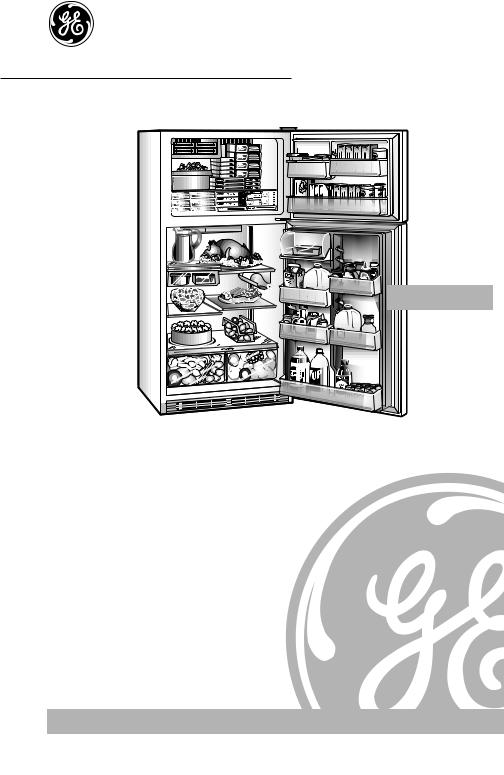
<![endif]>RefrigeratorsTop-mount no-frost
GE Appliances
Owner’s Manual
Models 18–25
GE Answer Center ® 800.626.2000
Part No. 162D3948P005 Pub. No. 49-6971
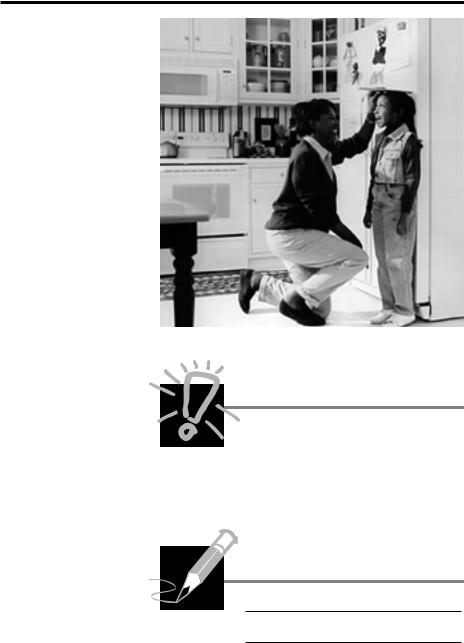
Congratulations!
You Are Now Part of the GE Family.
Welcome to the GE family. We’re proud of our quality products and we are committed to providing dependable service. You’ll see it in this easy-to-use Owner’s Manual and you’ll hear it in the friendly voices of our customer service department.
Best of all, you’ll experience these values each time you use your refrigerator. That’s important, because your new refrigerator will be part of your family for many years. And we hope you will be part of ours for a long time to come.
We thank you for buying GE. We appreciate your purchase, and hope you will continue to rely on us whenever you need quality appliances for your home.
 Important!
Important!
Staple sales slip or cancelled check here.
Proof of the original purchase date is needed to obtain service under the warranty.
Write the model and serial numbers here.
#
#
|
You can find them on a label on the |
|
left side, near the top of the fresh food |
2 |
compartment. |
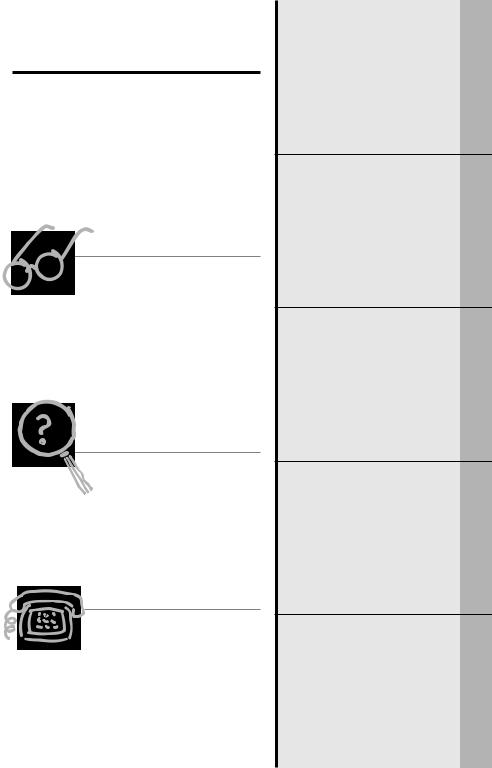
GE & You,
A Service Partnership.
Ask any GE appliance owner and they will tell you we stand behind our products with unmatched quality service. However, did you know that most questions result from simple problems that you can easily fix yourself in just a few minutes? This Owner’s Manual can tell you how.
Read this Manual
Inside you will find many helpful hints on how to use and maintain your refrigerator properly. Just a little preventive care on your part can save you a great deal of time and money over the life of your refrigerator.
Review the Section on
Troubleshooting Tips
You’ll find many answers to common problems here. If you review our chart of Troubleshooting Tips first, you may not need to call for service at all.
If You Need Service
If you do need service, you can relax knowing help is only a phone call away. A list of toll-free customer service numbers is included in the back section. Or, in the U.S., you can always call the GE Answer Center®
at 800.626.2000, 24 hours a day, 7 days a week. In Canada, call 1-800-361-3400.
Safety Information
Safety Precautions . . . . . . . . . . .4 How to Connect Electricity . . . .6 Use of Adapter Plugs . . . . . . .6, 7 Use of Extension Cords . . . . . . .7
Operating Instructions
Temperature Controls . . . . .8–10
Features . . . . . . . . . . . . . . .11–15
Automatic Icemaker . . . . . . . . .16
Ice and Water Dispenser . .17, 18
Care and Cleaning . . . . . . .19–21
Installation Instructions
Preparing to
Install the Refrigerator . . . .22, 23 Water Line Installation . . .24–28
Reversing the Door Swing/ Removing the Doors . . . . .29–36
Troubleshooting Tips
Normal Operating Sounds . . . .37
Before You
Call For Service . . . . . . . . .38–41
Customer Service
Warranty
for Canadian Customers . . . . .42
Warranty
for U.S. Customers . . . . . . . . . .43
Service Telephone
Numbers . . . . . . . . . .Back Cover
3
<![endif]>Service Customer Tips Troubleshooting Instructions Installation Instructions Operating Information Safety

<![endif]>Customer Service Troubleshooting Tips Installation Instructions Operating Instructions Safety Information
IMPORTANT SAFETY INFORMATION. READ ALL INSTRUCTIONS BEFORE USING.
 WARNING!
WARNING!
Use this appliance only for its intended purpose as described in this Owner’s Manual.
 SAFETY PRECAUTIONS
SAFETY PRECAUTIONS
When using electrical appliances, basic safety precautions should be followed, including the following:
|
■ This refrigerator must be |
|
properly installed and |
|
located in accordance with |
|
the Installation Instructions |
|
before it is used. |
|
■ Do not allow children to |
|
climb, stand or hang on the |
|
shelves in the refrigerator. |
|
They could damage the |
|
refrigerator and seriously |
|
injure themselves. |
|
■ Do not touch the cold |
|
surfaces in the freezer |
|
compartment when hands |
|
are damp or wet. Skin may |
|
stick to these extremely cold |
|
surfaces. |
|
■ Do not store or use gasoline |
|
or other flammable vapors |
|
and liquids in the vicinity of |
|
this or any other appliance. |
|
■ In refrigerators with |
|
automatic icemakers, avoid |
|
contact with the moving parts |
|
of the ejector mechanism, or |
|
with the heating element that |
|
releases the cubes. Do not |
|
place fingers or hands on the |
|
automatic icemaking |
|
mechanism while the |
4 |
refrigerator is plugged in. |
|
■Keep fingers out of the “pinch point” areas; clearances between the doors and between the doors and cabinet are necessarily small. Be careful closing doors when children are in the area.
■Unplug the refrigerator before cleaning and making repairs.
NOTE: We strongly recommend that any servicing be performed by a qualified individual.
■Turning the control to the OFF position does not remove power to the light circuit.
■Do not refreeze frozen foods which have thawed completely.

IMPORTANT:
PROPER DISPOSAL OF THE REFRIGERATOR
Child entrapment and suffocation are not problems of the past. Junked or abandoned refrigerators are still dangerous…even if they will sit for “just a few days.”
If you are getting rid of your old refrigerator, please follow the instructions below to help prevent accidents.
Before You Throw Away Your Old Refrigerator or Freezer:
■Take off the doors.
■Leave the shelves in place so that children may not easily climb inside.
CFC Disposal
Your old refrigerator has a cooling system that used CFCs (chlorofluorocarbons). CFCs are believed to harm stratospheric ozone.
If you are throwing away your old refrigerator, make sure the CFC refrigerant is removed for proper disposal by a qualified servicer. If you intentionally release this CFC refrigerant you can be subject to fines and imprisonment under provisions of environmental legislation.
<![endif]>Service Customer Tips Troubleshooting Instructions Installation Instructions Operating Information Safety
5

<![endif]>Customer Service Troubleshooting Tips Installation Instructions Operating Instructions Safety Information
IMPORTANT SAFETY INFORMATION. READ ALL INSTRUCTIONS BEFORE USING.
 WARNING!
WARNING!
HOW TO CONNECT ELECTRICITY
Do not, under any circumstances, cut or remove the third (ground) prong from the power cord. For personal safety, this appliance must be properly grounded.
The power cord of this appliance is equipped with a 3-prong (grounding) plug which mates with a standard 3-prong (grounding) wall outlet to minimize the possibility of electric shock hazard from this appliance.
Have the wall outlet and circuit checked by a qualified electrician to make sure the outlet is properly grounded.
Where a standard 2-prong wall outlet is encountered, it is your personal responsibility and obligation to have it replaced with a properly grounded 3-prong wall outlet.
The refrigerator should always be plugged into its own individual electrical outlet which has a voltage rating that matches the rating plate.
This provides the best performance and also prevents overloading house wiring circuits which could cause a fire hazard from overheated wires.
Never unplug your refrigerator by pulling on the power cord.
Always grip plug firmly and pull straight out from the outlet.
Repair or replace immediately all power cords that have become frayed or otherwise damaged. Do not use a cord that shows cracks or abrasion damage along its length or at either end.
When moving the refrigerator away from the wall, be careful not to roll over or damage the power cord.
|
|
USE OF ADAPTER PLUGS |
|
|
(Adapter plugs not permitted in Canada) |
|
|
|
|
|
Because of potential safety hazards under certain conditions, |
|
|
|
|
|
we strongly recommend against the use of an adapter plug. |
|
|
However, if you must use an adapter, where local codes permit, a |
|
|
temporary connection may be made to a properly grounded 2-prong |
6 |
|
wall outlet by use of a UL-listed adapter available at most local |
|
hardware stores. |
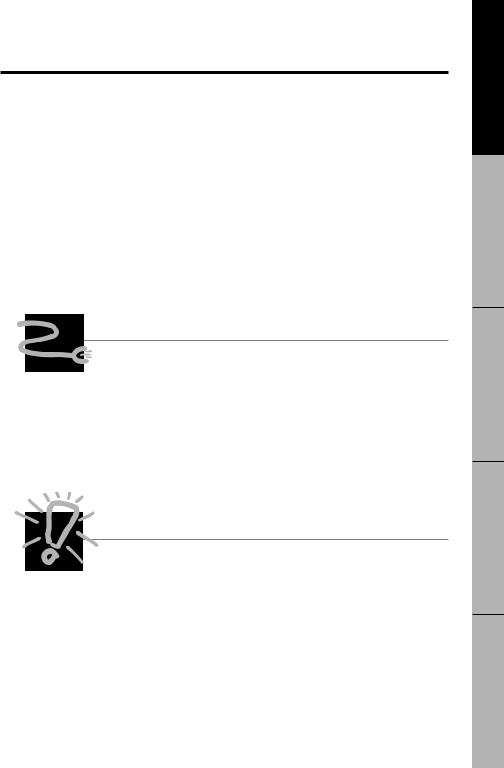
The larger slot in the adapter must be aligned with the larger slot in the wall outlet to provide proper polarity in the connection of the power cord.
When disconnecting the power cord from the adapter, always hold the adapter in place with one hand while pulling the power cord plug with the other hand. If this is not done, the adapter ground terminal is very likely to break with repeated use.
If the adapter ground terminal breaks, DO NOT USE the refrigerator until a proper ground has been established.
Attaching the adapter ground terminal to a wall outlet cover screw does not ground the appliance unless the cover screw is metal, and not insulated, and the wall outlet is grounded through the house wiring. You should have the circuit checked by a qualified electrician to make sure the outlet is properly grounded.
USE OF EXTENSION CORDS
Because of potential safety hazards under certain conditions, we strongly recommend against the use of an extension cord.
However, if you must use an extension cord, it is absolutely necessary that it be a UL-listed (in the United States) or a CSAlisted (in Canada), 3-wire grounding type appliance extension cord having a grounding type plug and outlet and that the electrical rating of the cord be 15 amperes (minimum) and 120 volts.
REMEMBER…
Your continued health and safety are important to us. Please read and follow this Safety Information carefully.
We want you to remain a happy and healthy part of our GE family.
SAVE THESE INSTRUCTIONS
<![endif]>Service Customer Tips Troubleshooting Instructions Installation Instructions Operating Information Safety
7
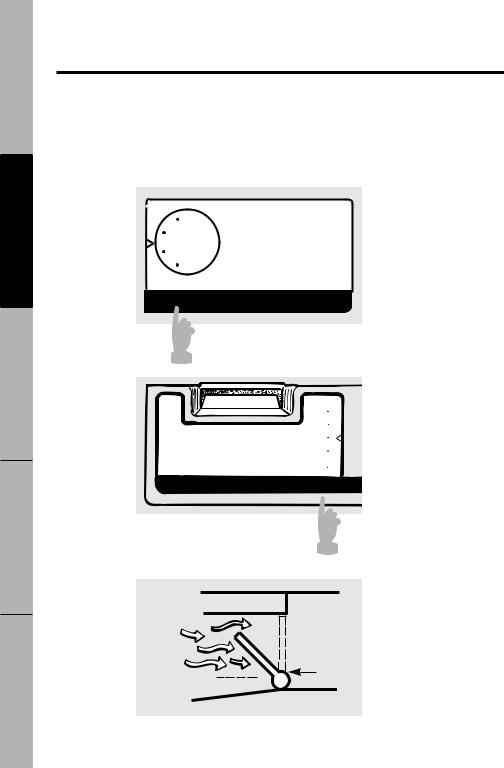
<![endif]>Customer Service Troubleshooting Tips Installation Instructions Operating Instructions Safety Information
About the controls on the refrigerator.
The temperature controls on your refrigerator have letters and numbers. Initially set the fresh food control at 5 and the freezer control at C.
If you want colder or warmer temperatures, adjust the fresh food temperature first. When satisfied with that setting, adjust the freezer temperature.
3 |
1 |
|
|
|
5 INITIAL SETTING |
||
5 |
|
||
OFF |
9 COLDEST |
||
|
|||
7 |
|
||
9 |
|
||
|
|
FRESH FOOD
1
Damper
|
E |
|
D |
INITIAL SETTING C |
C |
COLDEST E |
B |
FREEZER |
A |
2
E (Coldest setting)
Cold air |
C |
|
|
from freezer |
|
compartment |
|
Damper
(Warmest setting) A 




Side View
8
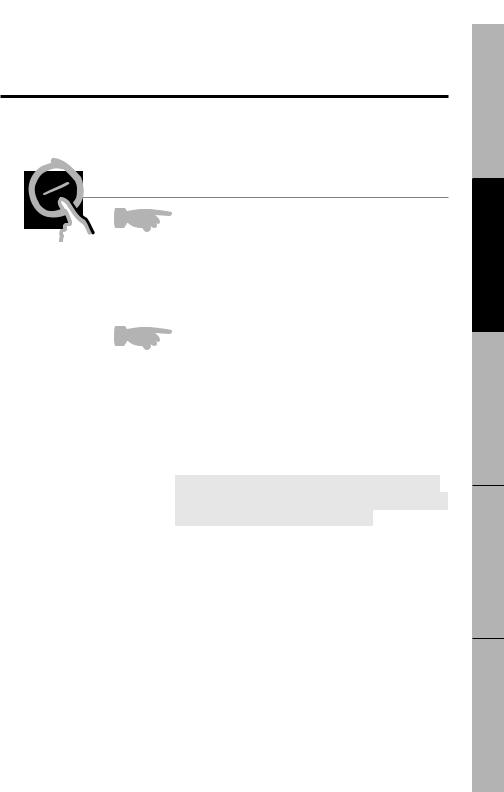
Control Settings
1 |
Fresh Food Control |
|
The fresh food control maintains the temperatures throughout the refrigerator.
Moving the fresh food control to OFF stops cooling in both areas—fresh food and freezer—but does not shut off power to the refrigerator.
2 |
Freezer Control |
|
The freezer control moves a damper to change the amount of cold air that moves from the freezer to the fresh food compartment.
Power Saver Switch
Push switch to the POWER SAVER setting to reduce the amount of electricity required to operate your refrigerator.
With this switch turned to the POWER SAVER setting, moisture may form on the outside of the refrigerator, especially when the weather is humid.
Over time, moisture that forms on the surface may cause rust.
To prevent moisture on the outside, move the power saver switch from the POWER SAVER setting.
Cost? About the same as it costs to use 2 night lights.
<![endif]>Service Customer Tips Troubleshooting Instructions Installation Instructions Operating Information Safety
9

<![endif]>Customer Service Troubleshooting Tips Installation Instructions Operating Instructions Safety Information
About the controls on the refrigerator.
How To Test Temperatures
Use the milk test for the fresh food compartment. Place a container of milk on the top shelf and check it a day later. If the milk is too warm or too cold, adjust the temperature controls.
Use the ice cream test for the freezer compartment. Place a container of ice cream in the center of the freezer and check it after a day. If it’s too hard or too soft, adjust the temperature controls.
After changing the controls, allow 24 hours for the refrigerator to reach the temperature you have set.
Food Storage
The type of packaging used and the storage temperatures will affect how long food will keep in the refrigerator.
New food storage guidelines are constantly being developed.
Consult the County Extension Service for the latest information on freezing and storing foods.
10
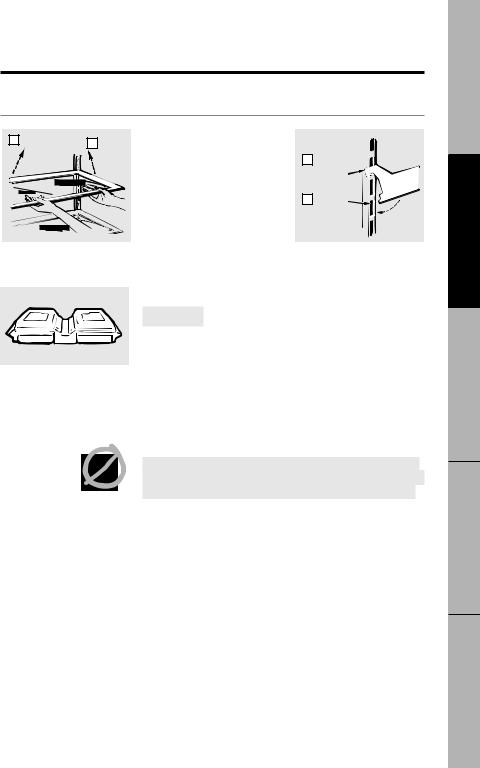
About the refrigerator shelves and dishes.
Not all features are on all models.
2 Lift up and out |
Rearranging the Shelves |
1 Tilt up |
|
|
Shelves in the fresh food |
|
and freezer compartments |
|
are adjustable. |
1 |
Insert |
|
top hook |
2 |
Lower to |
|
lock in place |
To Remove |
|
To Replace |
|
|
|
|
|
Quick Serve™ System
CAUTION: Dishes and lids are not designed for use on the range top, broiler or in the regular oven. Such use can be hazardous.
Quick Serve™ dishes fit into a rack that hangs on the fresh food or freezer door. The rack can be moved in the same manner as the door bins.
Dishes and lids are safe for use in microwave ovens, refrigerators and freezers.
Do not use when cooking high-fat foods, such as bacon, and highsugar foods, such as candy and syrup. The high temperatures of the fat and sugar can cause bubbles to form on the inside of the dish.
<![endif]>Service Customer Tips Troubleshooting Instructions Installation Instructions Operating Information Safety
11

<![endif]>Customer Service Troubleshooting Tips Installation Instructions Operating Instructions Safety Information
About the refrigerator bins.
Not all features are on all models.
To open: |
|
Quick Store Bin |
|
|
To avoid damaging the refrigerator, make sure the bin is |
||
1 |
Push up |
||
closed and latched before closing the refrigerator door. |
|||
S |
|
||
QUICK |
|
|
This bin can be placed on the fresh food or freezer doors.
2 Pull forward
To remove the bin, lift up and out of the bin housing.
Quick Store Bin
To move, lift the bin housing up and out of the supports on the door. You do not have to remove the bin from the housing when moving it.
Bin Housing
12
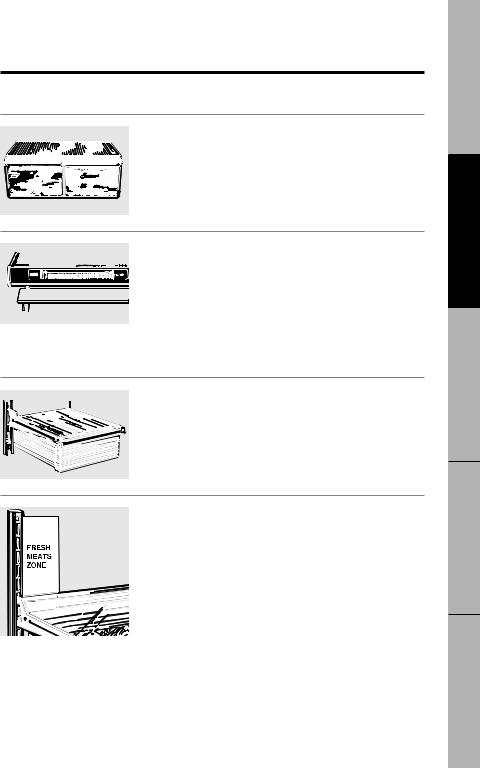
About the storage drawers.
Not all features are on all models.
Fruit and Vegetable Drawers
Excess water that may accumulate in the bottom of the drawers should be emptied and the drawers wiped dry.
Adjustable Humidity Drawers
Slide the control all the way to the HIGH setting to provide high humidity recommended for most vegetables.
Slide the control all the way to the LOW setting to provide lower humidity levels recommended for most fruits.
Snacks Drawer
The snacks drawer can be moved to the most useful location for your family’s needs.
Adjustable Temperature Meat Drawer
When the drawer is placed in the top 6 slots on the left side and the lever is set at COLDEST, air from the freezer is forced around the drawer to keep it very cold.
You can move the drawer to any location if you don’t want the extra cold storage.
The settings can be adjusted anywhere between COLD and COLDEST.
When set at COLD, the drawer will stay at the normal refrigerator temperature.
The COLDEST setting provides the coldest storage area.
<![endif]>Service Customer Tips Troubleshooting Instructions Installation Instructions Operating Information Safety
13

<![endif]>Customer Service Troubleshooting Tips Installation Instructions Operating Instructions Safety Information
About storage drawer and cover removal.
Not all features are on all models.
Storage Drawers
To Remove:
These drawers can be removed easily by lifting up slightly while pulling the drawers past the stop location.
When the door cannot be opened enough to pull the drawer straight out, slide the drawer toward the middle and remove it.
Remove the glass, then the frame. When replacing the glass, push the rear edge firmly into the frame.
Step 1 |
Step 2 |
|
Step 3 |
|
|
|
3 |
|
3 |
|
4 |
2 |
1 |
|
|
|
|
||
|
|
|
1 |
1 |
|
|
|
|
2 |
About the additional features.
Not all features are on all models.
Snuggers
Place a finger on either side of the snugger near the front to move the snugger back and forth to fit your needs.
14
